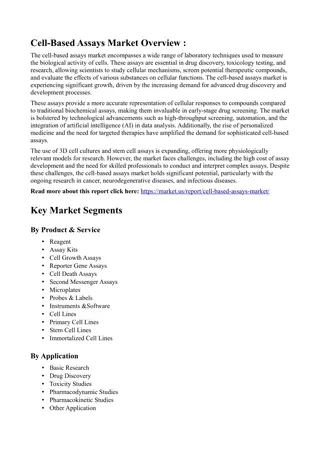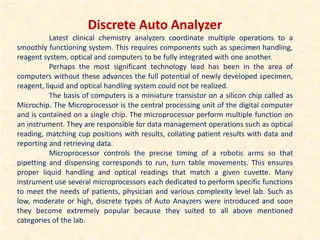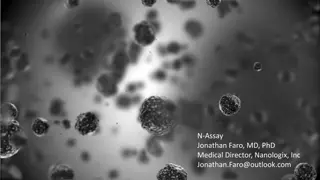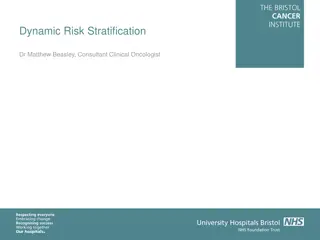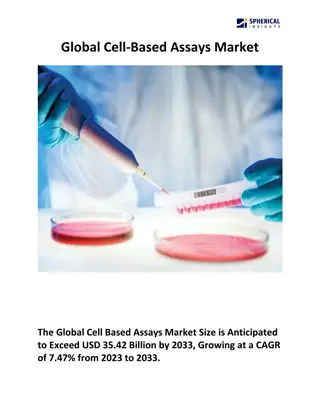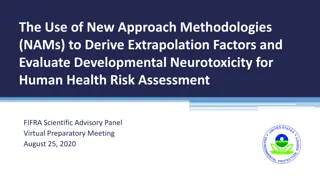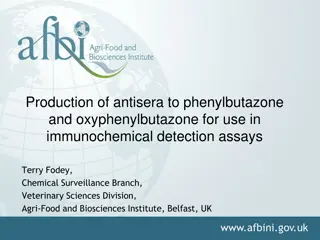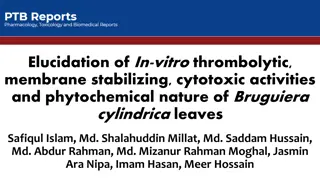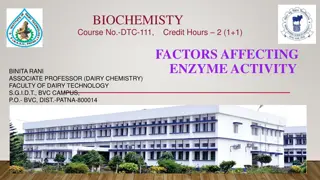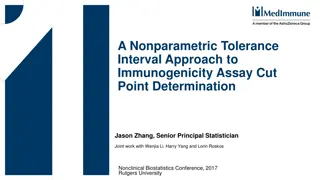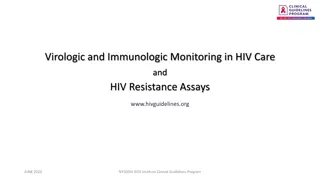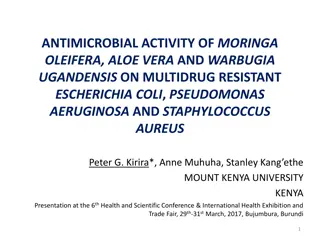Understanding Alinity i STAT High Sensitivity Troponin-I for Cardiovascular Diagnosis
Alinity i STAT High Sensitivity Troponin-I is a proprietary assay used in diagnosing myocardial infarction (MI) by quantitatively measuring cardiac troponin I in human plasma. This chemiluminescent microparticle immunoassay (CMIA) aids in the detection of MI, a significant aspect in managing heart d
2 views • 30 slides
Malaria Libre open project meeting
The Malaria Libre Open Project Meeting scheduled for 25/01/2024 will feature updates from key project members including Dr. Diego Gonzalez Cabrera and Dr. Didier Leroy. The meeting will cover an introduction to Malaria Libre, project updates, and allow for any other business discussions. The project
0 views • 27 slides
Biospecimen Collection, Storage, and Shipment Overview at USC Central Laboratory
This overview covers the types of biospecimens collected, specimen collection schedule, supplies, protocols, and shipping instructions at the USC Central Laboratory. It includes details on whole blood collection for different assays, storage procedures, and shipment to USC Labs and Charles River Lab
0 views • 21 slides
Understanding Cell Viability Assays in Laboratory Testing
Cell viability assays play a crucial role in determining the health and status of cells, measuring their ability to survive and proliferate. These assays involve various techniques such as dye exclusion, colorimetric, fluorometric, luminometric, and flow cytometric assays. By assessing factors like
6 views • 16 slides
Protein Assays Market
Protein Assays Market by Type (Dye-based, Copper-based) Technology (Fluorescence, Absorbance, Colorimetric) Offering (Reagent, Kit, Instrument) Application (R&D, Drug Discovery, Diagnostics) End User (Pharmaceutical, Hospital) \u2013 Global Forecast to 2031\n
2 views • 4 slides
Meticulous Research Publishes Comprehensive Report on Multiplex Assays Market
Multiplex Assays Market by Type (Protein [Bead, Planar], Nucleic Acid, Cell) Technology (Flow Cytometry, PCR, Immunoassay) Application (R&D, Diagnosis (Oncology, Cardiovascular, Infectious, Autoimmune Diseases) Product, End User - Global Forecast to 2030\n
0 views • 2 slides
Understanding Cerebrospinal Fluid Analysis
Explore the essential aspects of cerebrospinal fluid (CSF) analysis, from routine laboratory assays to interpretation of pathological conditions. Learn about CSF formation, normal parameters, and interpretation of lab results to diagnose various neurological conditions.
0 views • 76 slides
Cell-Based Assays Market
According to a recent report by Market.us, the Global Cell-based Assays Market size is expected to be worth around USD 37.1 Billion by 2032 from USD 16.3 Billion in 2022, growing at a CAGR of 8.8 % during the forecast period from 2023 to 2032.\n\n
0 views • 3 slides
Advancements in Discrete Auto Analyzers for Clinical Chemistry Operations
Discrete auto analyzers integrate specimen handling, reagent systems, optical components, and computers for streamlined functionality. The innovation in computer technology, particularly microprocessors, has revolutionized these analyzers, enabling precise data management, liquid handling, and optic
0 views • 17 slides
Understanding Peroxidase Enzyme Activity in Biological Samples
Demonstrating the enzyme activity of peroxidase, an enzyme that plays a crucial role in breaking down hydrogen peroxide in various organisms. Learn about the differences between peroxidase and catalase, the calculation of enzyme activity, and the significance of extinction coefficient in enzyme assa
0 views • 8 slides
Revolutionary N-Assay: Transforming Pathogen Detection in Healthcare
Innovative N-Assay developed by Jonathan Faro, MD, PhD, offers a faster, more accurate, and cost-effective solution for detecting bacterial pathogens in healthcare settings. Unlike traditional assays, N-Assay differentiates between viable and non-viable pathogens, provides information on antibiotic
1 views • 15 slides
Understanding Dynamic Risk Stratification in Thyroid Cancer Management
Dr. Matthew Beasley, a Consultant Clinical Oncologist, discusses the importance of Dynamic Risk Stratification in managing differentiated thyroid cancer. The process involves post-treatment monitoring through stimulated thyroglobulin (Tg) and neck ultrasound at specific intervals, aiding in determin
0 views • 16 slides
Understanding Antigen-Antibody Reaction: Agglutination Tests and Coombs' Antiglobulin Test
Learn about the principle and types of agglutination tests, including slide and tube agglutination, used for identifying bacterial isolates and blood grouping. Discover the importance of Coombs' test in detecting incomplete antibodies. Explore the applications and techniques involved in these immuno
2 views • 13 slides
MTT Cell Proliferation Assay: Protocol and Applications
The MTT cell proliferation assay is a widely used technique to measure cell viability, proliferation, and cytotoxicity in research. This colorimetric assay involves the conversion of MTT reagent to formazan dye by live cells, resulting in a purple color change. This comprehensive guide provides step
0 views • 8 slides
Understanding Haemophilia: Current Knowledge, Future Perspectives, and the Kenyan Scenario
Haemophilia is a genetic disorder affecting 1 in 10,000 deliveries, with joint bleeds being a common presentation. Bleeding episodes into joints can lead to chronic issues like synovial hypertrophy. Laboratory evaluation involves APTT testing and factor assays, with treatment including factor replac
0 views • 19 slides
Understanding Newborn Screening and T-Cell Receptor Excision Circles
The content discusses the importance of newborn screening, characteristics of disorders, T-cell receptor excision circles (TRECs), and the identification of severe conditions like SCID through TREC assay. It highlights the significance of early detection and treatment, emphasizing the value of high-
0 views • 7 slides
Global Cell-Based Assays Market
The Global Cell Based Assays Market Size is Anticipated to Exceed USD 35.42 Billion by 2033, Growing at a CAGR of 7.47% from 2023 to 2033.\n
1 views • 6 slides
Precision Medicine for Aggressive Lymphoma (PMAL) Consortium Overview
Tackling Diffuse Large B-cell Lymphoma, a clinical challenge with standard RCHOP care resulting in 75% cure rates but poor outcomes for relapsed patients. The PMAL Consortium is a national network spearheading diagnostic and therapeutic research to develop robust predictive molecular assays and test
0 views • 8 slides
Nuclear Non-Proliferation Treaty Compliance Measures Overview
Detailed overview of the measures implemented for verifying states' compliance with the Nuclear Non-Proliferation Treaty (NPT), including design verification, analysis of declarations, on-site inspections, assay of nuclear materials, and containment/surveillance techniques. The process involves dest
0 views • 9 slides
Advancements in Non-Animal Testing for Neurotoxicity Assessment
New Approach Methodologies (NAMs) are being developed to evaluate developmental neurotoxicity without the use of animal testing. The EPA is prioritizing efforts to reduce animal testing and is actively supporting the development of NAMs. These methodologies involve using in vitro assays to assess cr
0 views • 20 slides
Understanding Enzyme Assays in Biotechnology
Exploring enzyme assays in biotechnology, covering topics such as ELISA, protein assays, enzyme activity measurement techniques, specific activity, terminology related to enzyme assays, and different types of experiments conducted by biochemists to study enzyme-catalyzed reactions. The content delve
0 views • 53 slides
Antibody Production for Phenylbutazone and Oxyphenylbutazone Detection Assays in Veterinary Sciences
Terry Fodey, from the Veterinary Sciences Division in the UK, focuses on producing antisera for phenylbutazone and oxyphenylbutazone to use in immunochemical detection assays. The presentation covers the importance of antibodies, approaches to production, and performance comparison. Phenylbutazone,
0 views • 31 slides
Study on Phytochemical Nature and Biological Activities of Bruguiera cylindrica Leaves
Investigation of phytochemical constituents and biological properties such as thrombolytic, membrane stabilizing, and cytotoxic activities of Bruguiera cylindrica leaves. Phytochemical screening revealed the presence of carbohydrates, glycosides, phenols, tannins, proteins, gums, and mucilages. The
0 views • 16 slides
Insights into Animal Behavior and Hormones
Explore the fascinating world of animal behavior, from the deception of recognition mechanisms in gulls to Karl von Frisch's experiments on fish sensory abilities. Learn how behavioral assays shed light on animal sensory powers and how hormones play a crucial role in regulating animal behavior. Disc
0 views • 6 slides
Understanding Factors Affecting Enzyme Activity in Biochemistry
Enzyme assays measure substrate conversion to product under varying conditions like cofactors, pH, and temperature. Enzyme velocity represents the rate of a catalyzed reaction, typically reported as V0. Enzyme activity is expressed as mol of substrate transformed per minute, with enzyme unit and kat
0 views • 18 slides
Nonparametric Tolerance Interval Approach to Immunogenicity Assay Cut Point Determination
This content discusses the importance of determining the cut point for immunogenicity assays to detect anti-drug antibodies (ADA) in large-molecule therapeutics. It highlights the need for well-developed and validated assays to ensure drug efficacy and safety. The approach involves multiple-tiered v
0 views • 26 slides
Prospective Cohort Study on Acute HIV Infection in Bangkok
The study focuses on initiating combination antiretroviral therapy for all HIV-infected individuals to preserve the CD4+ T cell population, restrict viral reservoir seeding, and minimize viral evolution. Rapid suppression of HIV viraemia in patients could lead to potential candidates for future cure
0 views • 12 slides
Guidelines for Virologic and Immunologic Monitoring in HIV Care
These guidelines aim to assist clinicians in utilizing HIV viral load testing and CD4 count monitoring effectively in HIV care. They provide recommendations on the appropriate timing of tests to assess ART responses, address adherence barriers, and manage resistance assays. Regular monitoring is cru
0 views • 12 slides
Protein Purification Protocol: Practical Training in Biochemistry Techniques
This protein purification protocol course, led by Dr. Samina Hyder Haq, focuses on practical training in various biochemistry techniques. The course covers organizing experimental protocols, protein isolation strategies, sequential enzyme purification, enzyme kinetics, and writing scientific reports
0 views • 25 slides
Antimicrobial Activity of Moringa Oleifera, Aloe Vera on Multidrug-Resistant Bacteria
Antibiotic resistance poses a significant global health threat, leading to increased mortality and morbidity. This study investigates the antimicrobial properties of Moringa Oleifera, Aloe Vera, and Warbugia Ugandensis on multidrug-resistant Escherichia coli, Pseudomonas aeruginosa, and Staphylococc
0 views • 17 slides







